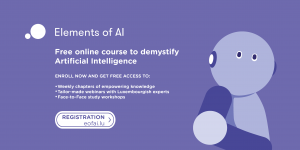
AI Unveiled: Breakthroughs, Integration, and Harmonious Coexistence
AI Unveiled: Breakthroughs, Integration, and Harmonious Coexistence
26 March 2024 - ICT
LetzAI co-founders, Misch Strotz and Karim Youssef, explore the current state of artificial intelligence (AI) and recent breakthroughs, particularly in Generative AI, challenging traditional views on human-exclusive creativity. They advocate for demystifying AI through education and transparency, discussing practical applications across industries.
Current State of AI: What is the current status of artificial intelligence, and what recent breakthroughs have shaped its development?
The recent breakthroughs in artificial intelligence, particularly in the domain of Generative AI, are nothing short of revolutionary. They have significantly broadened our understanding of creativity and computational capabilities, challenging the long-held belief that artistic creation and logical reasoning are the sole dominions of human intelligence.
When we talk about these advancements, we’re witnessing AI’s ability to not only analyze but also create. This includes generating art, composing texts with logical coherence, and producing videographic material that rivals human creativity. The development of video generation models, like OpenAI’s SORA, is a recent example. SORA can create complex and realistic video scenes from simple text inputs, showcasing an extraordinary leap in AI’s creative abilities. Similarly, Meta’s V-JEPA introduces a new architecture for self-supervised learning, trained on a vast amount of video data, pushing the boundaries of what AI can learn and create without explicit human annotation.
These advancements are powered by significant improvements in machine learning models, which have grown increasingly adept at processing and interpreting large datasets. Behind this incredible progress is also the evolution of hardware technology, exemplified by NVIDIA’s H100 series, which provides the computational power necessary to train these sophisticated models.
Demystifying AI for All: How can AI be demystified for both businesses and the general public to promote a more accessible understanding and broader adoption of this technology?
To achieve this, we should approach AI not as a distant, complex system understood only by experts, but as a set of existing tools and solutions that can enhance daily life, improve efficiency, and unlock new opportunities for creativity and innovation.
Firstly, education and awareness are key. Like with every new technology, we need to invest in educational initiatives that break down AI concepts into understandable components. This includes explaining how AI works, its potential benefits, and its limitations in a language that is accessible to everyone. For businesses, this means workshops and training sessions that illustrate practical AI applications in their specific industry, demystifying the technology and showcasing its tangible benefits.
Transparency also plays a critical role in demystification. By openly discussing how AI models are developed, trained, and deployed, as well as the data they use, we can build trust and understanding.
Highlighting ethical and responsible AI use is also important. By emphasizing how AI can be developed and used in ways that are ethical, responsible, and aligned with societal values, we can reduce fears and misconceptions. This includes addressing concerns about privacy, bias, and job displacement, and showing how AI can be a force for good, improving accessibility, healthcare, education, and more.
In this process, user-friendly consumer tools like LetzAI are key to enabling mass adoption and guaranteeing the necessary abstraction between technically complex tasks and the end user.
Concrete Aspects of AI: In practical terms, what is artificial intelligence, and how can it be integrated into various industries?
Artificial Intelligence (AI) is a branch of computer science that aims to create systems capable of performing tasks that typically require human intelligence. These tasks include understanding natural language, recognizing patterns and images, making decisions based on data, and learning from new information.
In practical terms, AI manifests through machine learning algorithms, neural networks, and other computational techniques that enable computers to undertake complex tasks autonomously or with minimal human intervention.
Integrating AI into various industries involves leveraging these capabilities to enhance efficiency, innovation, and decision-making.
For generative AI, the obvious use cases lie in creative tasks like for example Text and Image Creation. Already today it’s possible to create one’s own digital clone using tools like LetzAI, which can generate photorealistic portraits or brand and product photography.
In other industries, like the health industry, AI can revolutionize patient care by enabling personalized treatment plans through the analysis of vast amounts of medical data, significantly improving outcomes. On the other hand, AI-driven diagnostic tools can use Image detection to spot diseases from medical imagery with accuracy and speed unparalleled by traditional methods, making early intervention more feasible.
Understanding and Learning AI: How can individuals approach AI educationally and constructively? What are the most effective ways to comprehend its concepts and impact?
Given the depth of AI, a structured approach that combines theoretical learning with practical experience can be most effective. At the end of the day, it also depends on how deep you want to jump in. A combination of theory and practical exercises may be helpful as well.
People who are new to the topic should start with the basics:
There are numerous online platforms offering courses that cover the fundamentals of AI, machine learning, and data science. On platforms like YouTube, a lot of basic knowledge is available for free. As AI is one of the most hyped topics at the moment, the amount of available learning resources is nearly endless.
Funnily enough, one can also apply AI to learn about AI, for example by using tools like ChatGPT to ask them directly about AI.
For more technically advanced people, platforms like GitHub and HuggingFace are great starting points to dive deeper into the topic and experiment with practical applications and code.
One potential downside is that many AI applications require a lot of GPU resources, which are often not available to private users. However, there are more and more platforms that offer cheap compute for users who want to play around.
AI as a Trusted Companion: Can AI become a faithful companion in our daily lives, and what steps are needed to achieve a more harmonious interaction between humans and intelligent systems?
Envisioning AI as a trusted companion in our daily lives isn’t just a futuristic dream; for some it’s already a reality, shaped by advancements in technology that are making AI systems more intuitive, empathetic, and responsive.
Some of the most popular AI systems have already been designed with this “harmony” in mind. For example, if you use the ChatGPT app, you can talk to an extremely human sounding voice.
The purpose of these tools isn’t necessarily to form a bond in the traditional sense with its human counterpart, but rather to react in the most helpful way to any question a human asks. For example for programmers and developers, AI tools are already extremely helpful today and can boost productivity in never-seen-before ways, so it’s hard to think of going back to the old days, without automatic code correction and code suggestions.
To achieve a long-term harmonious interaction between humans and intelligent systems, it’s crucial that we focus on developing AI with transparency, security, and an emphasis on understanding human emotions and needs. This involves creating AI systems that can explain their decision-making processes in simple terms, ensuring robust security measures to protect user data, and integrating emotional intelligence to enable more natural and supportive interactions.
Moreover, incorporating human-centric design principles will ensure these systems are aligned with societal values and individual needs. This journey requires not just technological innovation but a collaborative effort that includes ethicists, policymakers, and the community at large, working together to ensure AI develops in a way that is beneficial, ethical, and enriching for everyone.
Elements of AI is a series of free online courses on Artificial Intelligence (AI) created by MinnaLearn and the University of Helsinki. The courses deliver the basics of what AI is, how it works and how it can be used. They combine theory with practical exercises and can be completed at your own pace. Join this uniquely fascinating MOOC on what AI really is, how it is created and how it will affect us in the coming years, now also in Luxembourg on: : https://www.elementsofai.lu/
This article is also available at: https://www.siliconluxembourg.lu/ai-unveiled-breakthroughs-integration-and-harmonious-coexistence-letzai/
Share this article on :


